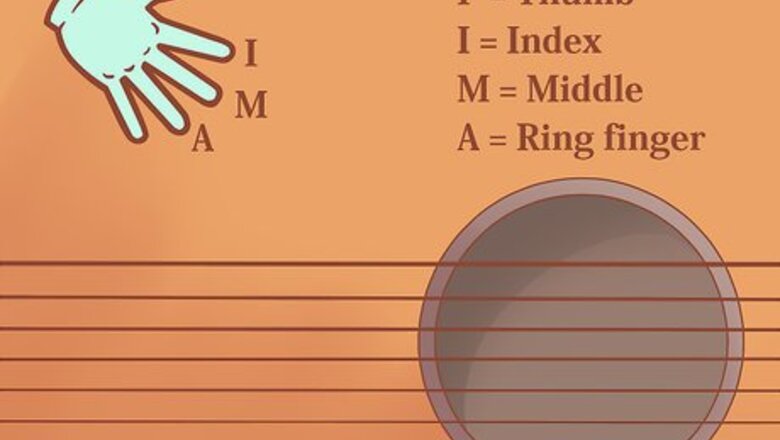
views
X
Research source
Training Your Fingers
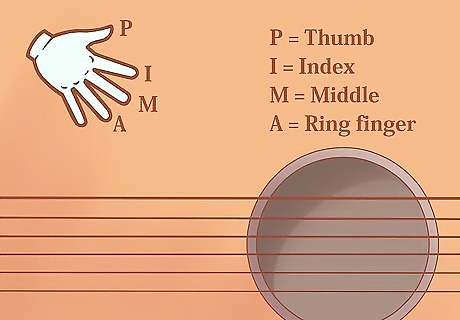
Position your hand over the strings of your guitar. Before you start learning fingerpicking patterns, get used to the position of your hand over the strings. Place your thumb over the sixth string, your first finger on the third string, your second finger on the second string, and your third finger on the first string. Maintain a slight arch in your wrist to isolate the muscles in your fingers. You want to keep your arm and wrist as still as possible while fingerpicking. All the movement comes from your fingers – not your arm or wrist. Some guitarists use their pinky to anchor their hand in position over the strings and restrict their wrist. However, others feel this limits their mobility. Try it and see what works best and feels most comfortable for you.
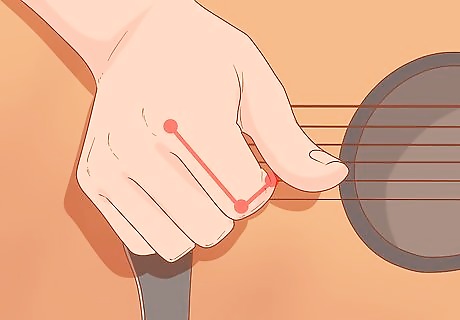
Curve all segments of your fingers. Each of your fingers has 3 joints. Maintain a slight curve in each joint of your fingers, as though you're holding an apple or tennis ball in the palm of your hand. Keep your wrist and fingers relaxed. Check your finger position. You may have to adjust your hand so that your fingers are over the correct strings.
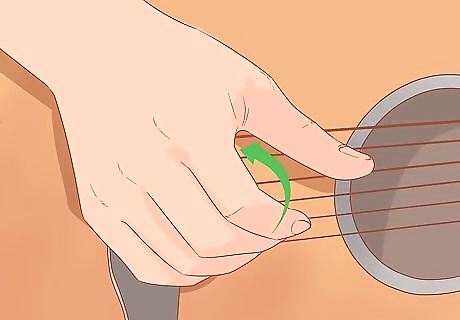
Curl your finger towards your palm to pick a string. To fingerpick a guitar, swing your finger towards your palm. All the movement should come from your base knuckle. Practice the motion with each of your first 3 fingers and your thumb. It can help to practice the movement without playing before you start plucking the strings. This will help your fingers learn to move independently of one another and build muscle memory. When you start plucking strings, approach them from the right angle. If you curl them correctly, this shouldn't be a problem. Ideally, you want to pluck the strings with your fingers at about a 90-degree angle from the strings.

Move your thumb from the base joint. You may think your thumb only has 2 joints, but it actually has 3, just like your fingers. You'll find it if you feel along the side of your hand as you bend your thumb inward towards the palm. The power of your thumb comes from the movement of this base joint, which is close to your wrist. Your thumb will be responsible for fingerpicking the sixth and fifth strings, the lowest notes of any chord. Use a full movement to create a powerful bass drone that lies underneath the higher notes.
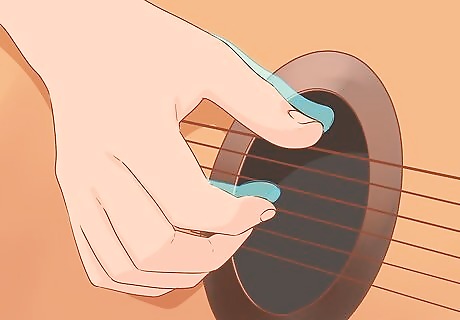
Try basic fingerpicking exercises. Fingerpicking exercises increase the ability of your fingers to move independently and get you ready to learn fingerpicking patterns. Simply strumming chords will get you used to the movement – you don't necessarily need to hunt down specific exercises (although they are available). For example, you can practice fingerpicking a G chord followed by a C chord. Play the lowest note of the chord with your thumb, the next lowest with your first finger, next with your second finger, and highest note with your third finger. If you want to try some more specific fingerpicking exercises, search online using search terms such as "fingerpicking exercises," "fingerstyle exercises," or "fingerpicking practice." Start out slowly, using a metronome to keep time. As you get the hang of it, you can gradually increase the speed.Tip: At first, you may feel as though your fingers keep getting tangled up with each other. Just remember to keep your fingers to the right of your thumb at all times.
Learning Fingerpicking Patterns
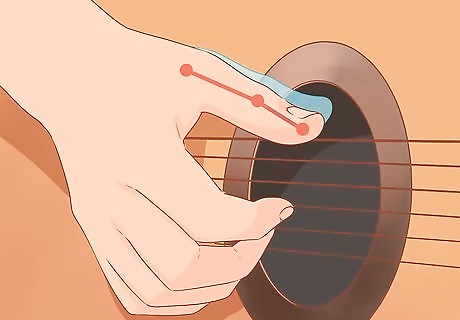
Keep a steady bassline going with your thumb. All fingerpicking patterns feature a steady bassline played by your thumb on the sixth and fifth strings of your guitar. Practice alternating between the lowest notes of 2 or 3 chords until you have a steady drone going. This basic pattern is known as "alternating bassline" picking, and it's one of the easiest fingerpicking patterns to pick up. Once your thumb is strong, you can start adding in the other notes of the chords with your other fingers. You can also just stick with the bassline, particularly when accompanying a singer or playing with a full band. Experiment until you get a sound that you like. Typically, you want to use a little more power with your thumb than you do with your other fingers. Otherwise, the higher notes in a chord will tend to overpower the root note.Tip: This style of fingerpicking is commonly known as "Travis picking" because it was popularized by Merle Travis. You can hear it in his songs, as well as songs by Chet Atkins and James Taylor.
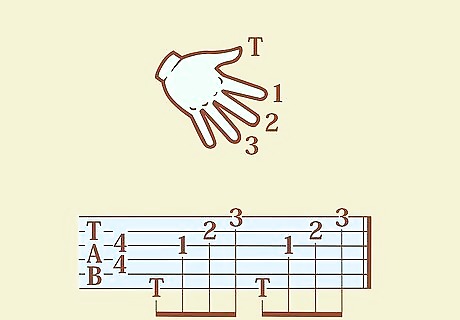
Use the basic fingerpicking pattern for songs in 2/4 or 4/4 time. The basic fingerpicking pattern mimics the exercises you did when you were learning how to fingerpick chords. Pluck the sixth string with your thumb, the third string with your first finger, the second string with your second finger, and the highest note on the first string with your third finger. Start with the bass note of the chord, then follow with the other notes. Repeat throughout the song, playing the chords this way. You can also alternate with strumming and fingerpicking to highlight particular chords in an arrangement.Variation: If you play this pattern backward, starting with the highest note and ending with the bass note, you'll produce a sound similar to part of the intro in "Stairway to Heaven."
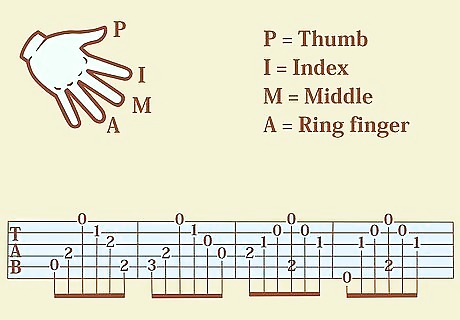
Try the "Rising Sun" pattern for songs in 3/4 time. This pattern is like the basic pattern, except that after you play the first 4 notes, you reverse direction and pluck the second string after the first string, followed by the third string. The full order of the strings for this pattern is 6-3-2-1-2-3. You can also alternate the bass note you play with your thumb if it happens to be on the fifth string rather than the sixth. This pattern gets its name from the song "House of the Rising Sun," but is also used in other folk and rock songs, including "Nothing Else Matters" by Metallica. It's more common to hear it in rock songs that are in 2/4 time.
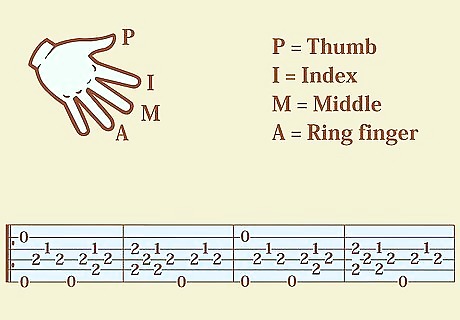
Learn the "Suzanne" to add variety and emotion to your fingerpicking. This pattern was named after the song of the same name by Leonard Cohen. To play it, pluck the fourth and second strings together with your thumb and second finger, then pluck the fourth string by itself. Follow up by plucking the fifth and first strings together, also with your thumb and second finger, then pluck the fourth string. Repeat as long as you want to play the pattern. This pattern can get monotonous if you try to play a whole song with it. However, it can be good for an intro or as an occasional accent. You can also hear it in the intro to "Sound of Silence," by Simon and Garfunkel.
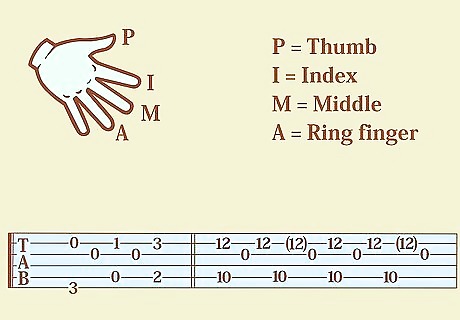
Challenge your fingerpicking with the "Blackbird" style. Like "Suzanne," this pattern is named after a song where it appears – in this case, "Blackbird" by the Beatles. For this pattern, pluck the sixth and first string together. Then pluck the fifth string, second string, sixth string, first string, and fourth string individually. Return to the start of the pattern, plucking the sixth and first string together. Which particular fingers you use aren't all that important, as long as you play the notes on the fifth and sixth strings with your thumbs. If you learned alternating bassline picking you'll have a leg up, since this pattern incorporates similar movements.
Mastering Your Fingerpicking Technique
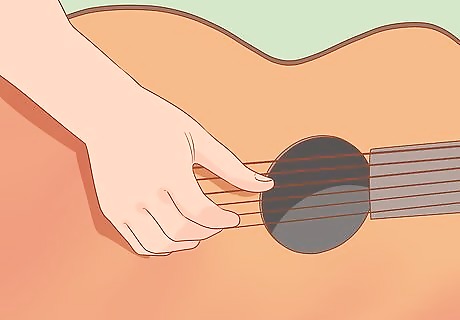
Practice every day to build muscle memory. It's unlikely that you'll pick up fingerpicking patterns after only a few practices. Try to dedicate at least 10 to 15 minutes a day to practicing fingerpicking specifically. Do exercises with chords to warm up and get your fingers used to playing the basic pattern. Then you can work on some of the more complex patterns. When you're practicing your fingerpicking technique, play songs you already know how to play really well. That way you won't be hunting for chords and can focus on your fingerpicking exclusively.
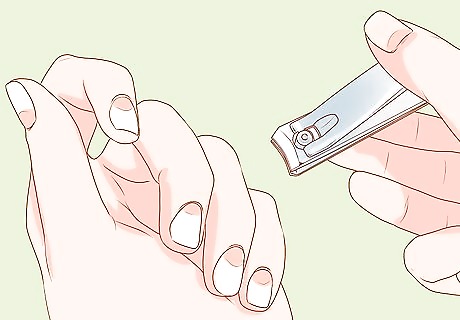
Decide whether you want to grow out your fingernails. Some guitarists who fingerpick on a regular basis grow out the fingernails on their picking hand while others prefer to keep them shorter. While the length is a matter of personal preference, stick to the same length consistently. If your nails are at different lengths, or if you grow them out one week and cut them short the next, you'll have difficulty fingerpicking consistently. Get in the habit of checking your nails every time you get ready to play your guitar. Keep a set of nail clippers in your guitar bag so you can trim them if necessary.Tip: If you decide to keep your fingernails short, fingerpicking will probably hurt your fingers for a little while until you build up callouses.
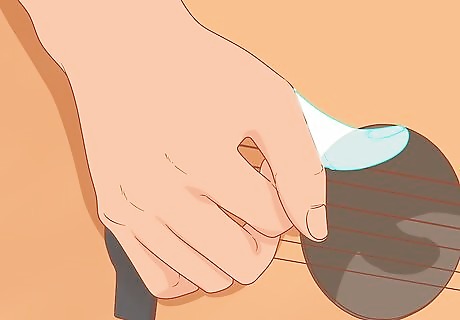
Play the bass note louder than the rest of the notes. Treble notes on any guitar chord outnumber the bass note. If you don't pluck the bass strings harder than the other strings they'll get drowned out by the treble strings. Practice plucking bass notes with your thumb until you can hit them strong enough that they'll ring out longer. This will give your playing power and depth. Alternating bassline picking is a good exercise to increase the strength of your bass notes.
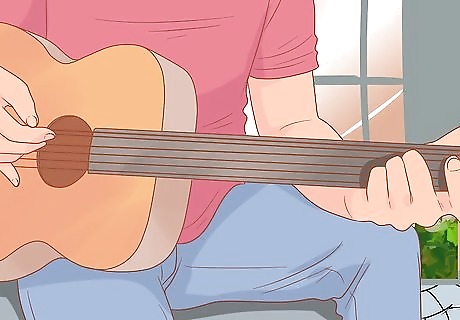
Emphasize the melody of the song and work chords around it. If you're accompanying a singer, look for notes in your guitar accompaniment that are the same as the melody. Prioritize those notes as you play, adding notes or chords around them. It can take some time to adjust to this style of play, as it is more difficult than other fingerpicking techniques. However, if you practice, you'll learn how to really enhance the melody of the song.
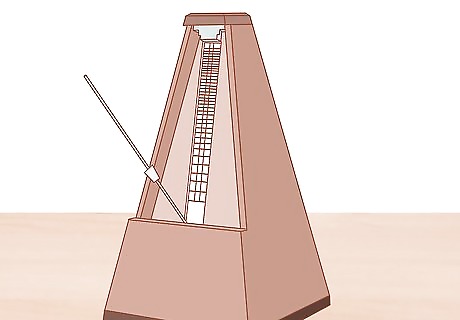
Use a metronome to ensure a consistent rhythm. You may have had no problem keeping time when you were strumming. However, when you start fingerpicking, it's easy to lose track of the rhythm – especially if you're playing around with melody notes and adding accents and color to the song. Practice with a metronome to ensure you're keeping consistent time. It can help to line up the bass note with the metronome. No matter what you do in the margins, if your bass note is in time, you'll be in time.



















Comments
0 comment